This article has multiple issues. Please help improve it or discuss these issues on the talk page . (Learn how and when to remove these template messages)
|
Sanjeev Khandekar is a reputed Marathi writer and visual artist based in Mumbai.
This article has multiple issues. Please help improve it or discuss these issues on the talk page . (Learn how and when to remove these template messages)
|
Sanjeev Khandekar is a reputed Marathi writer and visual artist based in Mumbai.
He was born in 1958. Kavita (Granthali, 1990) a collection of his early poetry and Search Engine (Granthali, 2004). These collections have been followed by three volumes of poetry - All that I Wanna Do (Abhida Nantar, 2005), Mutatis Mutandis (2006) and Two Poems (2006). His two books, '1,2,3... Happy Galaxy' and collection of present poetry 'Smiles' (2007) was published by Abhida Nantar in 2007.
In 1982, he edited Sankalp: A collection of essays by social activists in Maharashtra. It was awarded the Marathi Sahitya Parishad award. His second book, the novel Ashant Parva (Season of Unrest, 1992), concerns itself with the construction of a politically sensitive self in post-industrial India.
With his solo exhibition of watercolours, Rumour of the Truth (2003), held in Mumbai, Chennai and Delhi, Khandekar occasioned the arrival of his pictorial vocabulary. In 2004, his installation entitled, FLEX- The Fluid Less Sex, was on display at an International fashion show in New Delhi. The following year he exhibited two installations, "All That I Wanna Do" and "La Peau de Chagrin", at Museum Art Gallery and Pundole Art Gallery respectively. And though the exhibitions were held concurrently and addressed the plangent landscape of capitalism, Khandekar approached both the exhibitions fortified with two distinctive registers.
In mid-2006 Tits n Clits n Elephant Dick, his exhibition of paintings, sculptures and installations held at Jehangir Art Gallery, with contributions from Vaishali Narkar, became controversial when the Mumbai Police stopped its public viewing. The installation was an inquiry into the conflicting realities of market driven societies and their peculiar cultural logic.
He concluded the year 2006, with a solo exhibition of his painting and installations, What do I love when I love you, my God? At The Fourth Floor gallery in Mumbai. The works attempted to underline a link between shopping bulimia and religious fundamentalism, a last-ditch strategy for late capitalist, consumer societies.
In the year 2007,He had another solo exhibition,'Kegel Exercises' (Aswani Mudra) at Pundole Art Gallery, Mumbai. He displayed marble inlay works, inlaid with share market ticker tape and its abstract distortions. The show also included 'Encore' audio installation.
Same year, i.e. in 2007. He had one more major show titled as 'Acquire, Merge or Collaborate..' At Ashish Balram Nagpal Galleries, Mumbai; exhibition his paintings and a sculpture. He used scanned electron micrographs (SEM) images and share market ticker tape numbers to obtain a unique motif.
In the year 2008 Sanjeev had an exhibition titled 'In Everything You Ever Wanted to Know about Bad Breath but were Afraid to Ask Alfred Hitchcock (Part I)' [1]
In addition to these exhibitions Khandekar has partaken of several group and Web-based exhibitions. Khandekar has also written articles on environmental issues in various dailies and magazines. From 1990 to 1995, he edited the magazine Sujan, for an NGO of the same name.
Khandekar has worked on several international projects in senior managerial capacities, for both large Indian and multinational corporations.
Dilip Purushottam Chitre was one of the foremost Indian poets and critics to emerge in the post Independence India. Apart from being a notable bilingual writer, writing in Marathi and English, he was also a teacher, a painter, a filmmaker and a magazine columnist.

Atul Dodiya is an Indian artist.
Paresh Maity is an Indian painter. He is a prolific painter in a short career span. In 2014, Government of India conferred upon him its fourth-highest civilian award the Padma Shri.

Ranjit Hoskote is an Indian poet, art critic, cultural theorist and independent curator. He has been honoured by the Sahitya Akademi, India's National Academy of Letters, with the Sahitya Akademi Golden Jubilee Award and the Sahitya Akademi Prize for Translation. In 2022, Hoskote received the 7th JLF-Mahakavi Kanhaiyalal Sethia Award for Poetry.
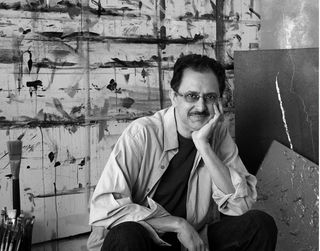
Jaideep Mehrotra is an Indian contemporary artist based in Mumbai, India. He started his artistic career with a solo exhibition at the young age of 13 in 1967. Despite having no formal training in art, Mehrotra managed a parallel career of business and painting up until 1983, when he embraced painting as his solitary profession.
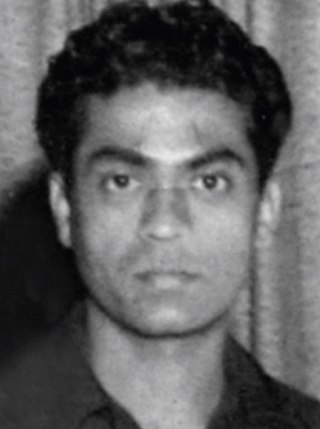
Vasudeo S. Gaitonde, also known as V. S. Gaitonde, was regarded as one of India's foremost abstract painters. He received the Padma Shri by the Government of India in 1971.
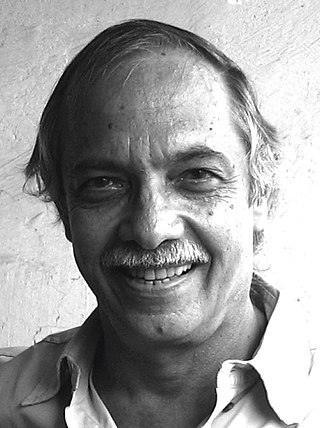
Gieve Patel was an Indian poet, playwright, painter, as well as a physician. He belonged to a group of writers who had subscribed themselves to the Green Movement which was involved in an effort to protect the environment. His poems speak of deep concerns for nature and expose man's cruelty to it. His notable poems include, How Do You Withstand (1966), Body (1976), Mirrored Mirroring (1991) and On killing a tree. He also wrote three plays, titled Princes (1971), Savaksa (1982) and Mr. Behram (1987).

Akbar Padamsee was an Indian artist and painter, considered one of the pioneers in modern Indian painting along with S.H. Raza, F.N. Souza and M.F. Husain. Over the years he also worked with various mediums from oil painting, plastic emulsion, water colour, sculpture, printmaking, to computer graphics, and photography. In addition, he worked as a film maker, sculptor, photographer, engraver, and lithographer. Today his paintings are among the most valued by modern Indian artists. His painting Reclining Nude was sold for US$1,426,500 at Sotheby's in New York on 25 March 2011.

Lalita Lajmi was an Indian painter. She was a self-taught artist born into a family involved in the arts, and was very fond of classical dance even as a child. She was the sister of Hindi film director, producer, and actor Guru Dutt. In 1994, she was invited to the Guru Dutt Film Festival, organised by Gopalkrishna Gandhi, the Indian High Commissioner at Nehru Centre, London. Her work was also influenced by Indian films such as those made by her brother, Satyajit Ray and Raj Kapoor.
Rashid Rana is a Pakistani artist. He has been included in numerous exhibitions in Pakistan and abroad with his works in abstractions on canvas, collaborations with a billboard painter, photographic/video performances, collages using found material, photo mosaics, photo sculptures, and large stainless steel works he is one of the best Pakistani artists.
Kalal Laxma Goud is an Indian painter, printmaker and draughtsman. He works in variety of mediums including etching, gouache, pastel, sculpture, and glass painting. He is best known for his early drawings that depict eroticism in a rural context, and also for the originality and quality of his etchings and aquatints.
Jatin Das is an Indian painter, sculptor and muralist. He is counted amongst the leading contemporary artists of India.
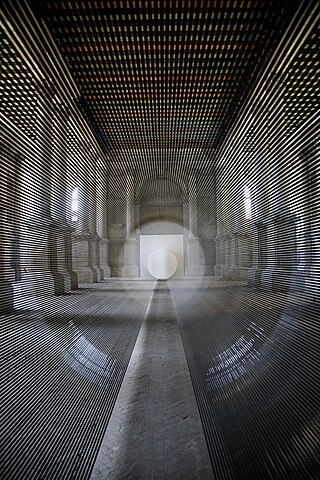
Žilvinas Kempinas is a contemporary visual artist. He lives and works in New York City.
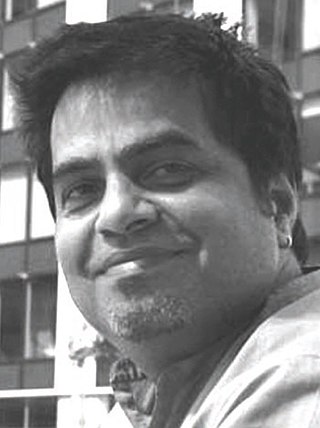
Sudarshan Shetty is a contemporary Indian artist who has worked in painting, sculpture, installation, video, sound and performance. He has exhibited widely in India and more recently he has become increasingly visible on the international stage as an important voice in contemporary art. His work has been exhibited at the Fukuoka Asian Art Museum, Fukuoka, Japan, and the Tate Modern, London, England. The artist has been a resident at the Mattress Factory, Pittsburgh, United States, and was a Ford Foundation Fellow at the New School for General Studies, New York.

Riyas Komu is an Indian multimedia artist and curator based in Mumbai. He has invested his time in art education and developing art infrastructure in India. Komu's works are inspired by social conflicts and political movements and topics like migration and displacement. His hyper-realistic oil portraits of people resemble socialist-realist propaganda art, with one of his portraits titled Why Everybody should Look Like Mao.
Chintan Upadhyay is an Indian artist. He was awarded the Charles Wallace Foundation Award for Residency in Bristol, UK in 2012. He began as a painter, but now creates sculptures and installations, the surfaces of which he paints.

Ebenezer Sunder Singh is an Indian-American visual artist based in Brooklyn, New York. Singh works primarily as a painter, sculptor, photographer and filmmaker.
Rajan Krishnan was a modern Indian artist based in Kerala.

Anju Dodiya is an Indian contemporary painter. She lives and works in Mumbai. Her paintings feature autobiographical and human relationships, with 'women' usually at the center.

Shiavax Dhanjibhoy Chavda was an Indian painter, illustrator and muralist. Known for his dynamic line drawings and paintings, Chavda's work mainly showcased the dancers and musicians from India and Southeast Asia.